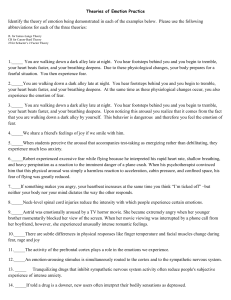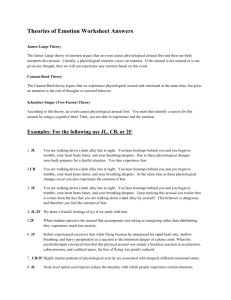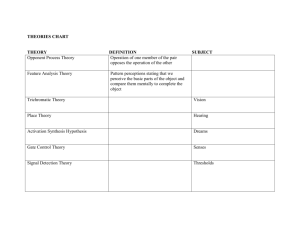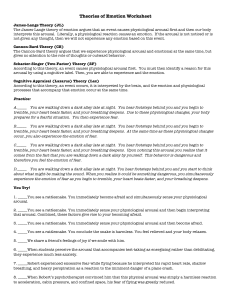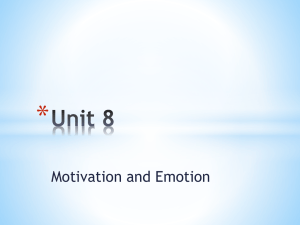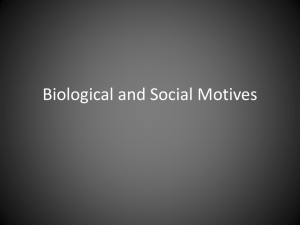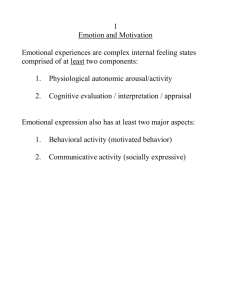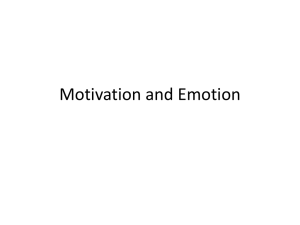February 6 - WordPress.com
advertisement
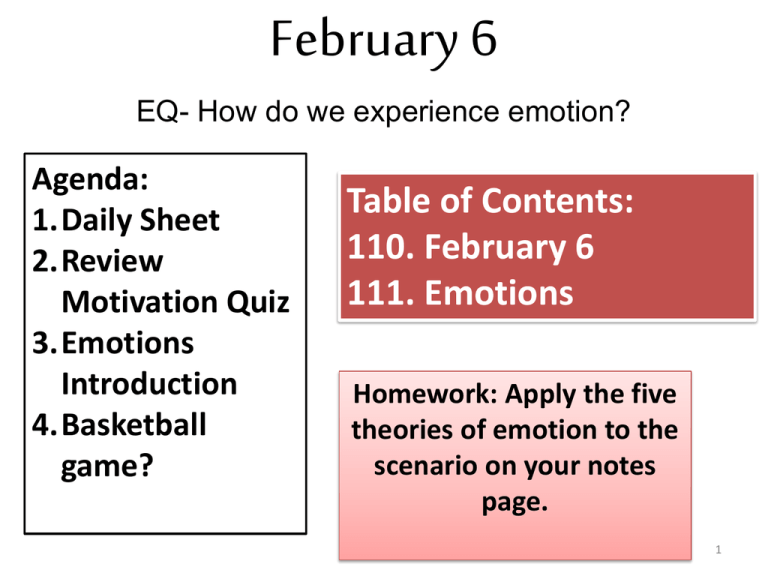
February 6 EQ- How do we experience emotion? Agenda: 1.Daily Sheet 2.Review Motivation Quiz 3.Emotions Introduction 4.Basketball game? Table of Contents: 110. February 6 111. Emotions Homework: Apply the five theories of emotion to the scenario on your notes page. 1 Vocabulary • Emotion- A response involving physiological arousal, expressive behaviors and conscious experience. Do NowWorking alone or with a partner, list as many emotions as you can think of!! 2 We Are Emotional Creatures: • Three words – Bridge to Terabithia • Joy – weddings • Grief – funerals • Jealousy – exboyfriend/girlfriend • Rage – driving • Happiness – passing a big test Inside Out 3 What IS Emotion? • Emotion involves: • 1. A subjective conscious experience (cognitive) • Accompanied by… • 2. Bodily arousal (physiological) • and • 3. A characteristic overt expression (behavioral) Think he brushes his teeth? 4 How do you feel when…? • You’re incredibly MAD: • You’re incredibly HAPPY: – Internal Body Response? – External Expressions/Actions – Internal Body Response? – External Expressions/Actions? What about: SCARED? NERVOUS? 5 What Causes Emotion(s)? • Neurotransmitters – Endorphins, serotonin • Autonomic Nervous System – Fight or flight • Endocrine system – Hormones • Amygdala – fear and anxiety • Frontal lobes – control interpretation of emotions • Right hemisphere – handles positive emotions • Left hemisphere – handles negative emotions 6 The Research: • Paul Ekman – found at least six basic facial expressions that are universally recognized by people all over the world – – – – – – Happiness Sadness Surprise Fear Disgust Anger • Each of these causes a distinct physiological, behavioral, and cognitive response 7 8 You’re alone… walking down a dark alley…. You hear footsteps behind you… What comes first? • The emotion of fear • Your body’s physical reaction of fear • You thoughts that this is dangerous and should be feared? 9 James-Lange Theory • event causes physiological arousal first • then we interpret this arousal. • Only after our interpretation of the arousal can we experience emotion. • If the arousal is not noticed or is not given any thought, then we will not experience any emotion based on this event. EXAMPLE: You are walking down a dark alley late at night. You hear footsteps behind you and you begin to tremble, your heart beats faster, and your breathing deepens. You notice these physiological changes and interpret them as your body’s preparation for a fearful situation. You then experience fear. 10 Cannon-Bard Theory • we experience physiological arousal and emotional at the same time, • no attention to the role of thoughts or outward behavior. EXAMPLE: You are walking down a dark alley late at night. You hear footsteps behind you and you begin to tremble, your heart beats faster, and your breathing deepens. At the same time as these physiological changes occur you also experience the emotion of fear. 11 Schachter-Singer Theory • • • • Aka Two-Factor Theory an event causes physiological arousal first. then identify a reason for this arousal then you are able to experience and label the emotion. EXAMPLE: You are walking down a dark alley late at night. You hear footsteps behind you and you begin to tremble, your heart beats faster, and your breathing deepens. Upon noticing this arousal you realize that is comes from the fact that you are walking down a dark alley by yourself. This behavior is dangerous and therefore you feel the emotion of fear. 12 Lazarus Theory • thought must come before any emotion or physiological arousal. • you must first think about your situation before you can experience an emotion. EXAMPLE: You are walking down a dark alley late at night. You hear footsteps behind you and you think it may be a mugger so you begin to tremble, your heart beats faster, and your breathing deepens and at the same time experience fear. 13 Facial Feedback Theory • emotion is the experience of changes in our facial muscles. • (when we smile, we then experience pleasure, or happiness. When we frown, we then experience sadness) • it is the changes in our facial muscles that cue our brains and provide the basis of our emotions. EXAMPLE: You are walking down a dark alley late at night. You hear footsteps behind you and your eyes widen, your teeth clench and your brain interprets these facial changes as the expression of fear. Therefore you experience the emotion of fear. 14
